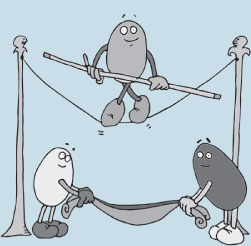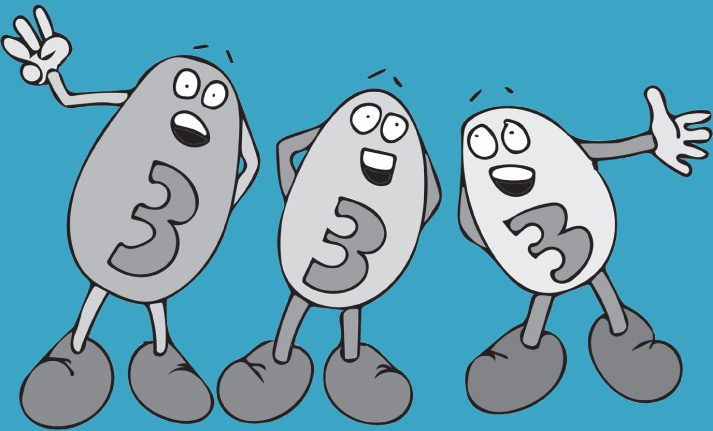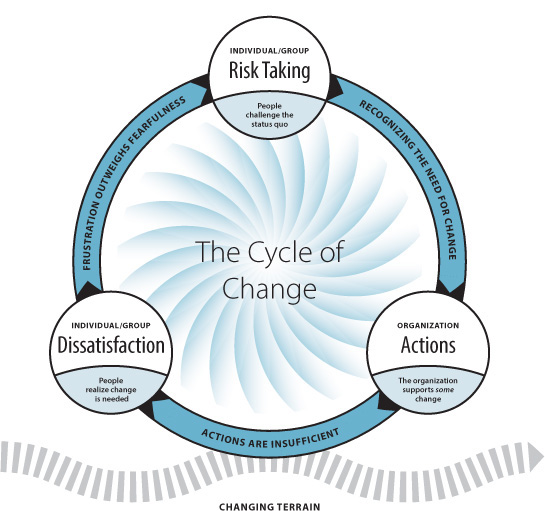
At Level Three, the organization moves from lip service to action.
(But it doesn’t happen everywhere.)
At Level Three, the organization aggressively works to create interaction safety. The organization and its leaders not only express the need for creating an environment in which honest, productive, and collaborative interactions occur; they take substantive actions to make it a reality. Interaction safety is recognized as foundational for a culture of inclusion and a path to higher performance for individuals, teams, and the organization.
But not everyone is on board with the effort. Many, including some of the leaders, still see interaction safety as primarily a human resources issue and not connected to the organization’s business outcomes or bottom-line interests.
As a whole, the organization’s new policies and actions are moving in the direction of greater interaction safety. However, the actions are not implemented throughout the organization. There are islands where interaction safety has become the standard way of operating, but there are other parts of the organization where the old “look out for yourself” culture still holds.

In some workgroups, interaction safety is seen as a route to better collaboration and more productive teams and partnerships.
But in others, it is still seen as “soft” and nonessential or as just another program of the month.
Some work teams quickly embrace the premise and practice of interaction safety, and their members thrive, both individually and collectively.
Some find it difficult to extend trust beyond the boundaries of their own tight circle of familiarity, or even within it. Others hold back. Some even hope that the effort fails so that they can soon return to the way things were.
And others look around and say to themselves, “I want what they have,” noticing that where there is more interaction safety, there is less turnover and better results.
But will it help them partner with a work team from another division? Willie is pleased with how quickly things are changing in the organization to make interaction safety a reality. He appreciates his team members and how they are working together.
When there are difficult issues, the team seems to rise to the occasion. Willie rarely finds himself censoring what he has to say, and other team members share their points of view freely and respectfully. They are a diverse team, and they often have honest conversations about their differences in background, experiences, and skill sets. They capitalize on those differences, especially when they are faced with complex problems or decisions.
However, Willie and his team have just been given a new task. They will need to work with a team from a different division, and he is not looking forward to it. The other team has a reputation for withholding data, being judgmental, and being unwilling to collaborate or address conflicts directly. They have not yet accepted the new way of interacting. When the two teams have worked together in the past, everything slowed down. People were frustrated by the lack of direct communication, the project suffered from the other team’s lack of input, and often there was a lack of agreement on the best actions to take. Working with the other team resulted in the project taking longer and costing more.
Willie is struggling with whether he will be able to build trust and collaboration with the other team if they are holding very different images of success and how to interact to achieve that success.
Willie takes a deep breath and walks into the meeting, ready to engage in a positive way . . . and hoping the feeling is mutual.
![]() Some individuals treat all their colleagues as partners and allies, but others still start every interaction from a judging mind-set.
Some individuals treat all their colleagues as partners and allies, but others still start every interaction from a judging mind-set.
![]() Certain parts of the organization are seen as desirable places to work because they are islands of interaction safety.
Certain parts of the organization are seen as desirable places to work because they are islands of interaction safety.
![]() While some human resources and management systems are changing to create a safe environment for interactions, the organization’s reward systems, policies, and practices are lagging behind the vision and are still not fully congruent with supporting interaction safety.
While some human resources and management systems are changing to create a safe environment for interactions, the organization’s reward systems, policies, and practices are lagging behind the vision and are still not fully congruent with supporting interaction safety.
![]() Individuals who are sometimes abusive are dealt with swiftly—coached, disciplined, or removed— and it is generally understood that such behavior is not acceptable. But in some workgroups and divisions, people still get away with it.
Individuals who are sometimes abusive are dealt with swiftly—coached, disciplined, or removed— and it is generally understood that such behavior is not acceptable. But in some workgroups and divisions, people still get away with it.
![]() Most people trust their team members, but some individuals still hold back.
Most people trust their team members, but some individuals still hold back.
![]() Leaders recognize that many people may be holding on to the past. They work hard to earn and build trust in every interaction.
Leaders recognize that many people may be holding on to the past. They work hard to earn and build trust in every interaction.
![]() Trust exists within the boundaries of a tight circle or workgroup.
Trust exists within the boundaries of a tight circle or workgroup.

For leaders, the job of creating interaction safety for others can start with trusting that its practice actually works.
Barbara knows leaders must learn to practice what they preach. Over the past few years, Barbara has seen many changes in how leaders are expected to interact with others. As a member of the senior leadership team, she feels confident about the team’s ability to serve as role models for the new environment they are working so hard to create.
Barbara believes her peers are committed to this new way of working, so she is surprised and concerned when she witnesses an incident in a meeting in which Paul, another senior leader, acts in ways that are counter to the new norms. Specifically, he talks over a few people and is unnecessarily critical of one of the team members.
Given the commitment to lean into discomfort and address disagreements, she decides she can’t let Paul’s behavior go without comment. After the meeting, she asks him if they can talk and if he is open to feedback.
Paul says that he is, and when they sit down together, Barbara describes the behaviors she witnessed and how she experienced them. She asks Paul what was going on, since his behavior seemed inconsistent with what he has said publicly regarding his commitment to supporting interaction safety and to demonstrating behaviors that create that environment.
At first, Paul is taken aback by Barbara’s comments. But as he thinks for a moment, he realizes he came into the meeting anxious about a personal matter and those feelings spilled over to the meeting. Paul thanks Barbara for her concern and for taking the time to talk with him honestly and in the spirit of interaction safety. He had not realized the toll the personal issue was having. They talk about how Paul can repair any damage he may have done with the people involved, and they agree to give each other feedback like this in the future.
Both Paul and Barbara agree that this conversation never would have happened before the organization began focusing on creating interaction safety. They see it as an example of being honest and authentic with each other and as a good model for how to collaborate for the greater good of the team and the organization.

We support each other and give each other the benefit of the doubt.
Well... many of us do, most of the time.
In an unsafe world, safety can’t be assumed, so we need to take conscious steps to create it every day.
How We Interact in Meetings: Level Three
“Normal” behaviors, interactions, and responses
Written rules and road signs |
Signs in the room promote interaction safety. |
When someone is talking |
People test whether this is a group in which interaction safety is a norm and respond accordingly. |
Interactions with the meeting leader |
People hold an expectation that they have something to offer. |
Interactions with other team members |
Interactions are free, open, and supportive. |
When someone challenges an idea |
The norm is to listen and try to see the other’s point of view. |
Outcome of interactions |
Uneven levels of skill and commitment lead to uneven outcomes. |

New people are often appreciated for their fresh perspectives...
. . . but given the islands of interaction safety, sometimes they feel like Ping-Pong balls.
Daniel is new to the organization. He has been spending a lot of time and effort trying to figure out how he fits into the culture and how best to interact with others and contribute. While the organization has clearly made a lot of strides in its commitment to creating an environment of interaction safety, it still has some way to go.
At times, Daniel feels like a Ping-Pong ball. In one setting, he finds the team starts its meetings by reaffirming norms for interaction safety and sees members really living and demonstrating those norms. However, in other meetings, it seems that interaction safety is not on anyone’s screen.
As he goes from meeting to meeting, he wonders: Which is the company’s true culture?
The Diversity and Inclusion Council is at a crossroad. Celia has been a member of the Diversity and Inclusion Council for some time and has been pleased to see how the organization has progressed in creating an environment in which it is safer to speak up, particularly with respect to issues of diversity and inclusion. However, as the Council discusses this progress, some are not as positive or optimistic about where the organization is or the strides that have been made.
Roberto shares that he is still experiencing the “old culture” of jokes and biases. They are unquestioned in his part of the organization. As the Council discusses the current state, they agree things are progressing well in some parts of the organization but not in others. Chen asks, “How many years have we been doing this? We need to determine whether we really have the support of the organization. Are the leaders serious, or are we just wasting our time? We all have day jobs!”
Council members agree there is resistance. Many feel that progress is moving way too slow in creating a more inclusive and diverse environment in which interaction safety builds a culture of trust and collaboration. But they also acknowledge that the changes are being made too fast for others.
The Council agrees that it is time to re-engage the senior leaders to reaffirm their commitment, get everyone on board, and move the effort to the next level.
Moving to the Next Level

Roots of Dissatisfaction
Here are some of the signs of dissatisfaction at Level Three.
![]() Interaction safety is applied and practiced inconsistently.
Interaction safety is applied and practiced inconsistently.
![]() People still remember the past, and many don’t fully trust their experience of interaction safety as sustainable.
People still remember the past, and many don’t fully trust their experience of interaction safety as sustainable.
![]() Interaction safety is not widely understood as critical to organizational success.
Interaction safety is not widely understood as critical to organizational success.
![]() The organization’s reward systems, policies, and practices are lagging behind the vision and are still not fully congruent with supporting interaction safety.
The organization’s reward systems, policies, and practices are lagging behind the vision and are still not fully congruent with supporting interaction safety.
![]() Some people assume that since they feel safe, others must as well. It can be hard for them to understand that the environment outside their bubble of safety might be different.
Some people assume that since they feel safe, others must as well. It can be hard for them to understand that the environment outside their bubble of safety might be different.
![]() Within teams, there are varying levels of interaction safety depending on the issue at hand—when timelines are tight and the pressure is on, they may revert to old behaviors.
Within teams, there are varying levels of interaction safety depending on the issue at hand—when timelines are tight and the pressure is on, they may revert to old behaviors.
![]() Islands are creating curiosity and a greater desire for interaction safety in other teams.
Islands are creating curiosity and a greater desire for interaction safety in other teams.

It’s time to soar! Let’s move to Level Four!
Individual Actions: Taking Risks
![]() Publicly hold yourself and others accountable for creating interaction safety in meetings and all interactions.
Publicly hold yourself and others accountable for creating interaction safety in meetings and all interactions.
![]() Be an ally for interaction safety for new people and others who are learning the culture.
Be an ally for interaction safety for new people and others who are learning the culture.
![]() Share what you are doing to create interaction safety and how it supports individual, team, and organizational effectiveness.
Share what you are doing to create interaction safety and how it supports individual, team, and organizational effectiveness.
![]() Show support and appreciation when others act to create interaction safety.
Show support and appreciation when others act to create interaction safety.
![]() When you don’t feel safe, be willing to lean into discomfort and let others know what you need to feel safe.
When you don’t feel safe, be willing to lean into discomfort and let others know what you need to feel safe.

Leaders:
Here are some things you can do to make interactions safer for your team members.
Leader and Organization Actions
![]() Work to make sure all human resources and management systems, policies, and practices fully support the creation of interaction safety, in both letter and spirit.
Work to make sure all human resources and management systems, policies, and practices fully support the creation of interaction safety, in both letter and spirit.
![]() Recognize that you and other leaders are learning and accept that there will be a learning curve. Actively engage to receive regular feedback on how (and what) you are doing, as individual leaders and as a group.
Recognize that you and other leaders are learning and accept that there will be a learning curve. Actively engage to receive regular feedback on how (and what) you are doing, as individual leaders and as a group.
![]() Recognize that the history of the lack of interaction safety won’t be undone quickly or easily. Actively work to build the necessary connections and relationships that build trust.
Recognize that the history of the lack of interaction safety won’t be undone quickly or easily. Actively work to build the necessary connections and relationships that build trust.
![]() Seek new ways to improve your ability to create and foster an environment of interaction safety.
Seek new ways to improve your ability to create and foster an environment of interaction safety.
![]() Talk to your team members about what they need for greater interaction safety and work to co-create that environment with your team members.
Talk to your team members about what they need for greater interaction safety and work to co-create that environment with your team members.
![]() Publicly praise team members who demonstrate behaviors that support interaction safety.
Publicly praise team members who demonstrate behaviors that support interaction safety.
![]() Create recognition awards for interaction safety.
Create recognition awards for interaction safety.
![]() In new-hire orientation and other training programs, include interaction safety as a key expectation for individual and organizational success.
In new-hire orientation and other training programs, include interaction safety as a key expectation for individual and organizational success.
![]() Track the impact of interaction safety on the achievement of organizational goals—for example, time to market, innovation, problem solving, and customer satisfaction.
Track the impact of interaction safety on the achievement of organizational goals—for example, time to market, innovation, problem solving, and customer satisfaction.

On to Level Four






